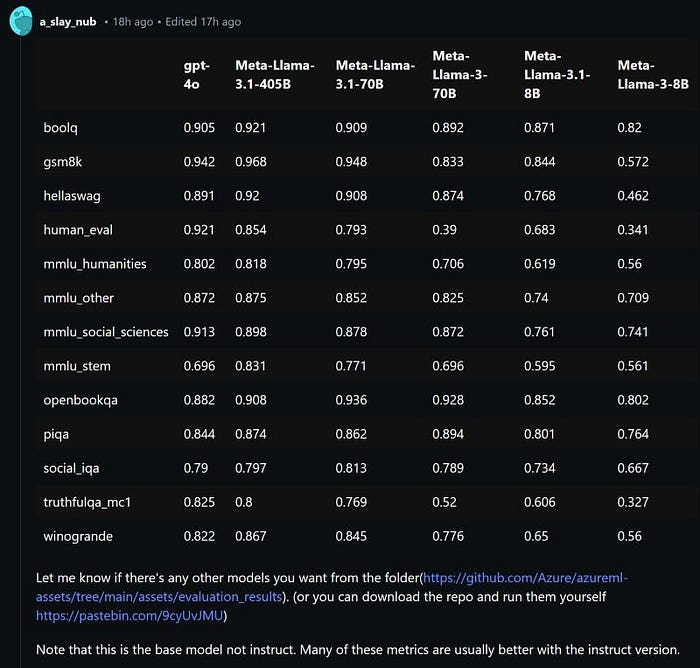- Weekly AI News
- Posts
- Meta "Llama 3.1" With 405B Parameters Is Out!
Meta "Llama 3.1" With 405B Parameters Is Out!
Meta has just announced the release of Llama 3.1, the latest version of its Llama artificial intelligence model. This new model comes in three versions, including the most advanced AI model Meta has ever created. True to its roots, Llama 3.1 continues to be open source, meaning it’s accessible to everyone for free.

Meta’s Llama 3.1 405B May Outperform OpenAI’s GPT-4o. Image from digitalinformationworld
This launch is a testament to Meta’s significant investment in AI, aiming to keep pace with other industry leaders like OpenAI, Anthropic, Google, and Amazon.
A Deepening Partnership with Nvidia

Image from https://nvidianews.nvidia.com/
A notable aspect of this release is the growing collaboration between Meta and Nvidia. Nvidia provides the GPUs crucial for training Meta’s AI models, including Llama 3.1. While companies like OpenAI monetize their proprietary models, Meta has no plans to enter the enterprise tech market in a similar way. Instead, Meta collaborates with tech giants like Amazon Web Services, Google Cloud, and Microsoft Azure to offer Llama 3.1 through their platforms.
Open Source Strategy and Its Benefits
Meta CEO Mark Zuckerberg has previously mentioned that while Meta does generate some revenue from these partnerships, the primary goal is different. By making Llama and related technologies open source, Meta aims to attract top talent and reduce its computing costs. Additionally, this approach fosters a community of developers who can improve and build upon Meta’s tools, ultimately benefiting the company internally.
The Role of Llama 3.1 in Meta’s Ecosystem
The timing of Llama 3.1’s release coincides with a conference where Zuckerberg and Nvidia CEO Jensen Huang will speak. Meta, a significant Nvidia customer, relies on the latest GPUs to train its models. The largest version of Llama 3.1, the 405B model, was trained using 16,000 of Nvidia’s H100 processors. This collaboration is mutually beneficial; Meta gets the GPUs it needs, and Nvidia sees increased demand for its chips as Meta’s open-source models encourage widespread adoption.
What Llama 3.1 Brings to the Table

Image from reddit.com
The Llama 3.1 family includes the massive 405B model, boasting 405 billion parameters. This high number of parameters allows the model to perform complex tasks, such as understanding long text contexts, solving intricate math problems, and generating synthetic data. Smaller models, Llama 3.1 8B and 70B, are also available for applications like chatbots and coding assistants.
Hands-On with Llama 3.1
Meta is offering a hands-on experience with Llama 3.1 for U.S.-based WhatsApp users and visitors to the Meta.AI website. Users can interact with Meta’s digital assistant powered by Llama 3.1, capable of answering complex questions and solving coding problems. Users can choose between the large 405B model and smaller, faster versions for their queries.
A Unique Approach to AI Development
Zuckerberg wrote in a blog post on Tuesday that it was taking a “different approach” to the Llama release this week, adding,
“We’re actively building partnerships so that more companies in the ecosystem can offer unique functionality to their customers as well.”
Since Meta doesn’t operate as an enterprise vendor, it can direct businesses interested in Llama to its enterprise partners like Nvidia.
Broader Implications for AI Development
Some developers say the new Llama release could have broad implications for AI development. Stella Biderman, executive director of EleutherAI, an open-source AI project, also notes that Llama 3 is not fully open source. But Biderman highlights that a change to Meta’s latest license will let developers train their own models using Llama 3, something that most AI companies currently prohibit. “This is a really, really big deal,” Biderman says.
Unlike OpenAI and Google’s latest models, Llama is not “multimodal,” meaning it is not built to handle images, audio, and video. But Meta says the model is significantly better at using other software such as a web browser, something that many researchers and companies believe could make AI more useful.
Addressing AI Safety Concerns
Meta is enhancing AI safety by collaborating with global organizations like NIST and ML Commons to define common standards and best practices. They conduct thorough risk assessments and red teaming, partnering with AWS and Nvidia to integrate safety into AI deployment. Their tools, Llama Guard 3 and Prompt Guard, help developers detect and mitigate risks like cybersecurity threats and prompt injections, ensuring safe AI applications. Meta’s approach includes sharing resources and evaluations, enabling developers to tailor AI safety measures to their needs while advancing research in AI safety.
Additionally, Meta focuses on comprehensive risk evaluations in cybersecurity, chemical and biological weapons, child safety, and privacy. They conduct detailed testing and mitigation efforts, such as fine-tuning models and developing tools like CyberSecEval 3 to address specific threats. Their commitment to transparency and safety involves open sourcing work and collaborating with experts to refine AI models continuously, ensuring they meet high safety standards and support responsible AI development.
Meta’s vision for AI safety extends to providing developers with a robust foundation through tools like Llama Guard 3 and Prompt Guard, integrated into their Llama reference system. These tools help detect harmful content and protect against malicious inputs. By offering these resources and engaging in extensive safety evaluations, Meta aims to empower developers to build safe and effective AI applications. They continue to prioritize openness, sharing their advancements and safety measures to foster collaboration and innovation in the AI community. Further details are provided in their research paper.
P.s. Llama 3.1 is too large to run on a regular computer, but Meta assures that many cloud providers, such as Databricks, Groq, AWS, and Google Cloud, will offer hosting options to enable developers to run custom versions of the model. Additionally, the model can be accessed directly at Meta.ai.
If you want more updates related to AI, subscribe to our Newsletter
Reply